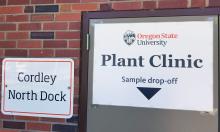There are several plant disease diagnostic facilities based in the Pacific Northwest that can help determine the identity of pathogens involved in plant problems. Publicly supported clinics are listed below. A listing of other plant analytical facilities, both public and private, that provide testing and/or diagnostic services can be found at https://extension.oregonstate.edu/catalog/pub/em8677.
For best service, and for the most useful returns on your efforts and for efficient use of our time, please read and observe these instructions before submitting specimens.
Collecting diseased specimens for diagnosis
- Select material showing the symptoms you are concerned about. Send several samples showing various stages of disease, especially early symptoms. If possible, also send a sample of a healthy plant.
- Submit whole plant, including roots when practical. Dig out the plant and do not yank the plant out of the soil/media. For relatively small plants, tie a plastic bag around the roots so the soil does not get onto the shoots during shipping. For relatively large plants, enclose the roots and soil in a plastic bag, and use another bag to enclose the rest of the plant.
- If it is not practical to send the entire plant, include several affected portions of the plant (e.g., large tree, landscape plant). With stem or branch disorders, the sample should include live material as well as the diseased portion. In other words, include the margin between healthy and diseased tissue. For leaf spot disorders, keep the leaves attached to the stems or branches.
- If a vascular wilt such as Verticillium wilt or Dutch elm disease is suspected on a tree, send several branch sections that are at least 1 inch in diameter and 6 inches long from branches exhibiting dying, wilted, or yellowed leaves. Do not send only dead wood. Put samples in a plastic bag to prevent drying.
- Turfgrass samples should be taken from the edges of affected areas that include dying and also apparently healthy plants. Send one or two squares of sod that are at least 5-by-5-inches and with 1 inch of attached soil. Wrap each sample in a dampened paper towel, then in dry newspaper.
- Fleshy specimens such as mushrooms, fruit, or potatoes should be as firm as possible and show early and intermediate stages of symptom development. Wrap specimens separately in dry paper towels or newspaper. Do not put in plastic. Pack with sufficient padding to avoid crushing.
Packing diseased specimens for shipping
- Keep plants cool and moist before shipping. Mail as soon as possible after collection. Mail specimens early in the week to avoid delays in the post office over weekends or holidays.
- Pack in a box or sturdy container to prevent crushing in transit. Use packing material to prevent the contents from moving around inside the container.
- If sending multiple samples in one box, label each sample bag inside the box with a name or number (i.e., an identifier). Include information of each sample in the clinic's submission form, and place the form in a plastic bag and put it in the box.
Addressing Packages
Oregon (accepts both domestic or international samples):
OSU Botany and Plant Pathology
Attn.: OSU Plant Clinic
2503 Cordley Hall
2701 SW Campus Way
Corvallis, OR 97331-2903
Phone: 541-737-3472
E-mail: extpp@science.oregonstate.edu
Sample forms, fee information, directions to the OSU Plant Clinic, are available at: https://bpp.oregonstate.edu/plant-clinic
Oregon (accepts samples from Northeast Oregon and North Central Oregon only):
Extension Plant Pathology Laboratory, 2121 S. First, OSU, Hermiston OR 97838 (Fees required).
Idaho:
Plant Diagnostics, Parma Research and Extension Center, 29603 U of I Lane, Parma ID 83660
Plant Diagnostics, Idaho Falls Research and Extension Center, 1776 Science Center Dr., Suite 205, Idaho Falls ID 83402
Western Washington:
Plant & Insect Diagnostic Lab, WSU Puyallup, 2606 West Pioneer, Puyallup WA 98371-4998 (Fees required).
Eastern Washington:
(USPS) Plant Pest Diagnostic Clinic, Dept. of Plant Pathology, PO Box 646430, Pullman WA 99164-6430 (Fees required)
(UPS and FedEx) Plant Pest Diagnostic Clinic, Dept. of Plant Pathology, 410 Dairy Road, Pullman WA 99164 (Fees required).
British Columbia:
Plant Health Laboratory, British Columbia Ministry of Agriculture and Food, 1767 Angus Campbell Rd., Abbotsford BC V3G 2M3 Canada (Fees required). https://www2.gov.bc.ca/gov/content/industry/agriculture-seafood/animals-and-crops/plant-health/plant-health-laboratory
Information to accompany disease specimens
Fill out the appropriate Plant Disease Form or Plant Disease Identification Request sheets with as much information as possible. These forms are available in your county Extension offices, the labs listed above and on the web at
This information is valuable as an aid to diagnosis. Some labs will not process samples unless a form has been filled out. Photographs or even video tapes convey a lot of information that may be useful. The more information you provide, the more accurate the diagnosis will be.
Note: Neither the OSU nor the WSU clinics are allowed to accept cannabis samples (marijuana) due to university regulations. However, The OSU Plant Clinic does accept industrial hemp samples from registered growers who submit a copy of their license to grow. Additionally, the Oregon Department of Ag Plant Health can provide disease diagnostics services for both the industrial hemp and marijuana industries. Cannabis samples for diagnosis by the Oregon Department of Ag must be submitted in person by appointment only.


